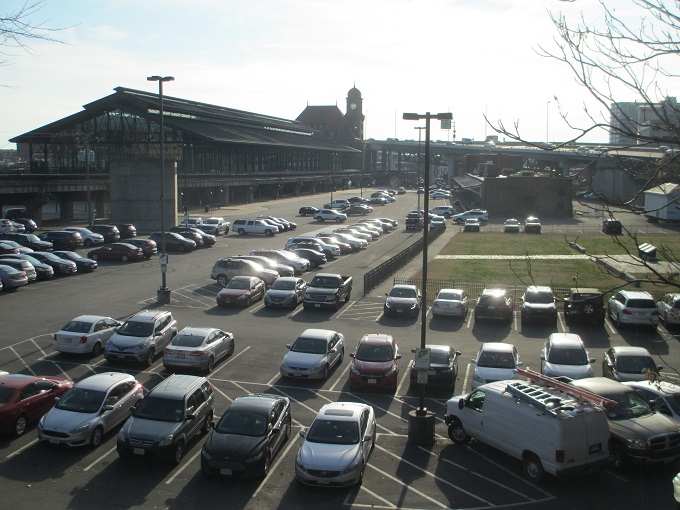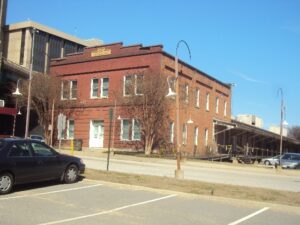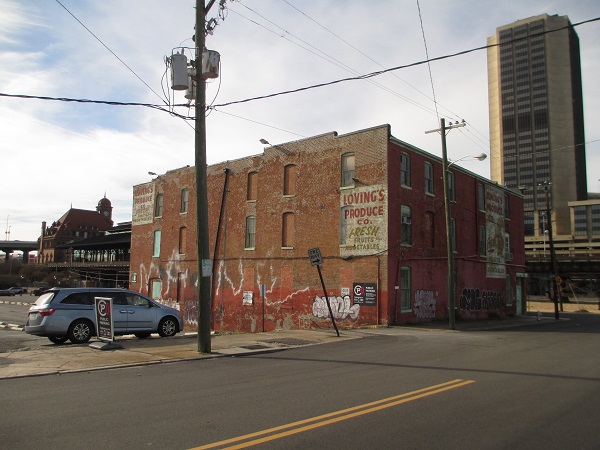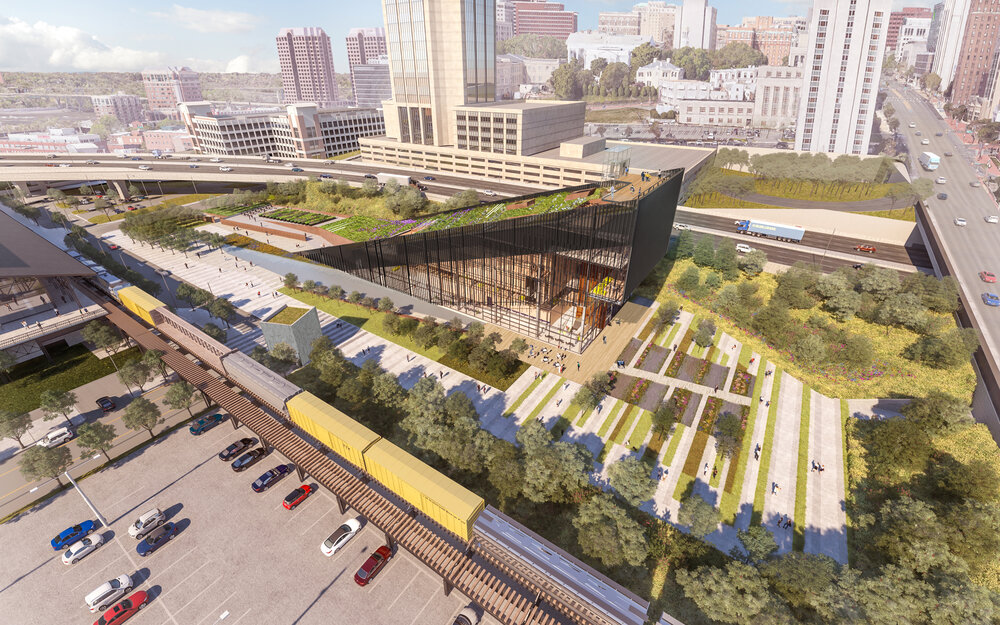
Main Street Station’s train shed is adjacent to sites that would form the Shockoe Bottom Heritage Campus, including the Lumpkin’s Jail/Devil’s Half Acre site visible to the right. (BizSense file photos)
Two years after it opened the door to using eminent domain if needed for the project, the City of Richmond is looking to nail down a location for a planned slavery museum that would anchor a larger commemorative site in Shockoe Bottom.
At a committee meeting this week, City Councilmember Cynthia Newbille reported that administrators have begun vetting options for the planned National Slavery Museum, which would anchor the likewise in-the-works Shockoe Bottom Heritage Campus.
Newbille, whose Seventh District includes the Bottom, had planned to request a feasibility study of potential locations, but asked to defer that request a month in light of a meeting she’d had earlier that day with Mayor Levar Stoney, administrative staff and members of the National Slavery Museum Foundation, the privately led group developing the museum.
Newbille said the meeting included a presentation of efforts underway to vet properties near the Lumpkin’s Jail/Devil’s Half Acre site, the epicenter of Richmond’s slave-trading history. Where her request would have asked for a report by June 30, she said those efforts were on track to produce a report by June 1, just before the committee’s next monthly meeting.
“I would like to go on and give opportunity for that work to happen. It’s in progress,” Newbille said.
Noting that the process would consider environmental challenges in light of the area’s 100-year floodplain, Newbille added, “I think everyone left (the meeting) feeling that we were well on our way to vetting and coming back to the table with some options for that entity’s location in the Shockoe area.”
Newbille’s request would have asked for three or more recommendations for locating the museum, including whether the properties are city-owned or privately owned, their value, and how the city would acquire a property if needed.

The Seaboard Building on Franklin Street, between Main Street Station and the interstate. (City property record)
The request specified the city-owned Seaboard Building just south of the Lumpkin’s site as an option to be considered, as well as both city-owned and privately owned properties where the museum could be constructed “in close proximity” to the Lumpkin’s site. The grassy site is right beside Interstate 95 between Broad Street and Main Street Station.
Other properties near the site include Main Street Station’s train shed, where an interpretive center that would link to the heritage campus is planned to fill the northern end of the structure’s first floor.
Another option could be the former Loving’s Produce property and other parcels owned by the Loving family, whose holdings are generally east of the train shed. The city has eyed that land for possible inclusion in the heritage campus since at least 2021, when the City Council authorized staff to proceed with acquiring the Loving family’s 12 parcels there, which total nearly 2 acres.
That process was to involve conducting appraisals of the parcels, negotiating a sale and, if negotiations aren’t fruitful, potentially taking the properties through the city’s eminent domain powers. The Lovings have said they are open to a sale but oppose the city taking their land through eminent domain.

The Loving properties near Main Street Station include the former Loving’s Produce building at Grace and Ambler streets.
Stephen Clarke, an attorney for the Loving family, said Wednesday that they had not heard from the city or been approached about a sale.
“It’s been a lot of silence from the city for years now on this project,” said Clarke, a partner with Norfolk firm Waldo & Lyle. “Certainly if they reach out to us, we’ll consider anything that they have at that point.”
Through its five-year Capital Improvement Plan, the city has committed nearly $28 million in funding for the campus, which is projected to cost $38 million. It has also allocated $10 million, of which $3 million has been spent, to assist with siting analysis and design for the museum and other campus-related projects. The state has allocated $12.5 million for the museum and improvements to the Richmond Slave Trail.
In December, the city was awarded an $11 million grant from the Andrew W. Mellon Foundation for development and initial operations of the Main Street Station interpretive center, which is envisioned to serve as a starting point for the campus.

A conceptual rendering of the slavery museum, which had been envisioned between the train tracks and the interstate. (File image courtesy of SmithGroup)
In addition to the museum, the campus is planned to include a memorial park that would encompass the African American Burial Ground and Devil’s Half Acre sites. The two blocks that involve the Loving land have been planned to be used as an archaeological site and house the park’s memorial and other campus features.
The city’s public works department owns some of the land in the two blocks, which are now parking lots. The Lovings’ parcels line the 200 block of 17th Street and most of the block that contains the Loving’s Produce building.
According to an update in March on the city’s website, a hydrology and hydraulic study for the campus has been completed by Greeley and Hansen, a local environmental engineering firm the city hired last fall. The work focused on the area’s location in a floodway and aimed to identify limitations to existing flood control infrastructure. The city also has hired Baskervill to design the campus.

Main Street Station’s train shed is adjacent to sites that would form the Shockoe Bottom Heritage Campus, including the Lumpkin’s Jail/Devil’s Half Acre site visible to the right. (BizSense file photos)
Two years after it opened the door to using eminent domain if needed for the project, the City of Richmond is looking to nail down a location for a planned slavery museum that would anchor a larger commemorative site in Shockoe Bottom.
At a committee meeting this week, City Councilmember Cynthia Newbille reported that administrators have begun vetting options for the planned National Slavery Museum, which would anchor the likewise in-the-works Shockoe Bottom Heritage Campus.
Newbille, whose Seventh District includes the Bottom, had planned to request a feasibility study of potential locations, but asked to defer that request a month in light of a meeting she’d had earlier that day with Mayor Levar Stoney, administrative staff and members of the National Slavery Museum Foundation, the privately led group developing the museum.
Newbille said the meeting included a presentation of efforts underway to vet properties near the Lumpkin’s Jail/Devil’s Half Acre site, the epicenter of Richmond’s slave-trading history. Where her request would have asked for a report by June 30, she said those efforts were on track to produce a report by June 1, just before the committee’s next monthly meeting.
“I would like to go on and give opportunity for that work to happen. It’s in progress,” Newbille said.
Noting that the process would consider environmental challenges in light of the area’s 100-year floodplain, Newbille added, “I think everyone left (the meeting) feeling that we were well on our way to vetting and coming back to the table with some options for that entity’s location in the Shockoe area.”
Newbille’s request would have asked for three or more recommendations for locating the museum, including whether the properties are city-owned or privately owned, their value, and how the city would acquire a property if needed.

The Seaboard Building on Franklin Street, between Main Street Station and the interstate. (City property record)
The request specified the city-owned Seaboard Building just south of the Lumpkin’s site as an option to be considered, as well as both city-owned and privately owned properties where the museum could be constructed “in close proximity” to the Lumpkin’s site. The grassy site is right beside Interstate 95 between Broad Street and Main Street Station.
Other properties near the site include Main Street Station’s train shed, where an interpretive center that would link to the heritage campus is planned to fill the northern end of the structure’s first floor.
Another option could be the former Loving’s Produce property and other parcels owned by the Loving family, whose holdings are generally east of the train shed. The city has eyed that land for possible inclusion in the heritage campus since at least 2021, when the City Council authorized staff to proceed with acquiring the Loving family’s 12 parcels there, which total nearly 2 acres.
That process was to involve conducting appraisals of the parcels, negotiating a sale and, if negotiations aren’t fruitful, potentially taking the properties through the city’s eminent domain powers. The Lovings have said they are open to a sale but oppose the city taking their land through eminent domain.

The Loving properties near Main Street Station include the former Loving’s Produce building at Grace and Ambler streets.
Stephen Clarke, an attorney for the Loving family, said Wednesday that they had not heard from the city or been approached about a sale.
“It’s been a lot of silence from the city for years now on this project,” said Clarke, a partner with Norfolk firm Waldo & Lyle. “Certainly if they reach out to us, we’ll consider anything that they have at that point.”
Through its five-year Capital Improvement Plan, the city has committed nearly $28 million in funding for the campus, which is projected to cost $38 million. It has also allocated $10 million, of which $3 million has been spent, to assist with siting analysis and design for the museum and other campus-related projects. The state has allocated $12.5 million for the museum and improvements to the Richmond Slave Trail.
In December, the city was awarded an $11 million grant from the Andrew W. Mellon Foundation for development and initial operations of the Main Street Station interpretive center, which is envisioned to serve as a starting point for the campus.

A conceptual rendering of the slavery museum, which had been envisioned between the train tracks and the interstate. (File image courtesy of SmithGroup)
In addition to the museum, the campus is planned to include a memorial park that would encompass the African American Burial Ground and Devil’s Half Acre sites. The two blocks that involve the Loving land have been planned to be used as an archaeological site and house the park’s memorial and other campus features.
The city’s public works department owns some of the land in the two blocks, which are now parking lots. The Lovings’ parcels line the 200 block of 17th Street and most of the block that contains the Loving’s Produce building.
According to an update in March on the city’s website, a hydrology and hydraulic study for the campus has been completed by Greeley and Hansen, a local environmental engineering firm the city hired last fall. The work focused on the area’s location in a floodway and aimed to identify limitations to existing flood control infrastructure. The city also has hired Baskervill to design the campus.




When that location was proposed for a baseball park, the engineers actually designed the field to accommodate two feet of flooding during major storms. I’ve heard that the city is buying an island. If you plan to build in a flood plain anyway . . . Why not put it in a gorgeous spot than between I-95 and a rail line? Just put it on stilts!
Probably because that is not where the slaves were kept and sold. Shockhoe Bottom was the center of the slave trade in this country and is therefore a more appropriate spot for such a museum.
I would think the location would be great for both visibility and accessibility, never-mind the historical significance of the property. The Marine Corps museum is a great example of strong visibility from I-95. If I recall properly, the original plans included a lot of vegetation to handle excess storm-water flow, of which still appears to be the case in the above renderings.
Is this a “real” National museum, or are they just using the “National” moniker. $38M does not seem like enough money to build the campus they rendered. If this is a real National museum, then the Feds should pay – not the state.
Is Victoria Woodhull your “real” name? Or are you simply using the name of the first female presidential candidate? In either case how are you qualified to know what things cost when you can’t even get what the $38 million is for out of an article. It is for the adjacent “campus” and not for the actual museum shown in the rendering.
This project should not wait on the Feds. They can’t even get simple things done (see yesterday’s article on HUD properties). Why wait on them?
David – thank you for the google search. Do you google everyone who comments on OPINION blogs – or just the ones you disagree with to gain ammunition against them? How about letting me opine without calling me unqualified to have an OPINION.
And I agree, if the City wants to move faster – then you are correct – don’t wait on the Feds.
I often do. I like to know if someone is real or not so that I can try and assess the weight I put on their comments. If they are simply a keyboard warrior hiding behind someone else’s name I tend to put less weight on it.
David – I am OK with you putting less weight on my OPINION comments. And I am not a warrior. I am just a person who hides behind someone I admire.
I fully support recognizing how slavery impacted our country and before Richmond spends money on any huge new expenditures like this as a city, we have way too many infrastructure needs to address.
As for this specific location, I was working downtown when Hurricane Gaston hit in 2004 and this area is not a good location for anything similar to the rendering shown. Whatever is built here needs to be able to sustain a flood and this rendering doesn’t appear to account for flood mitigation based on how low it seems to be to the ground.
So whatever happened to the $11M that Gov McDonnell allocated by in FY13/14. I mean this project has been discussed for almost 20 years now and we are again debating its location site. In the midst of a city with a faltering Diamond project, non-moving city center project and some still think the City administration will be able to take this on too. Support the museum but if you want to see it come to fruition they need a new museum board and they need to take the City OUT of the process as the lead development coordinator (it can… Read more »
Deja vu all over again.
Our country needs a place to contemplate, educate, mourn, and generally reckon with our original sin of slavery, and Richmond should/could be that place. Former Gov Wilder has said the same for years. We need to think big on this – to creatively imagine and then build a place where people will come from all over the world to see and contextualize what occurred here, and what it wrought. And unlike a minor league baseball stadium that only attracts county dwellers for a few hours, this would attract thousands – to stay the night, to eat and drink locally, and… Read more »
Who designed this “wedge”looking thing? Architecture at it’s finest right there.
What’s worse that or the Reynolds wrap bldg.?
I just returned from Montgomery Alabama and was inspired and impressed by their museums: Rosa Parks Museum, Equal Justice Initiative Museum and the Lynching Memorial. The content of the museums was thorough, educational and professionally presented. None of the museums were on the actual sites of slave jails, bus boycotts or lynchings. My point is that the museum could be in the train shed and the sites(lumpkins Jail, etc.) near the train shed be upgraded for visitors. Don’t overthink this and fall victim to paralysis by analysis.
20+ years, countless millions spent on “studies”, consultants etc. Who is getting rich on this? The city record on this sort of thing is not too great…….